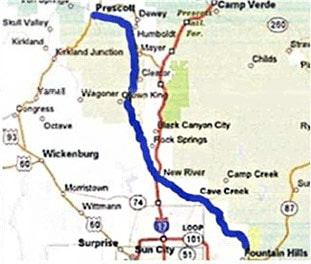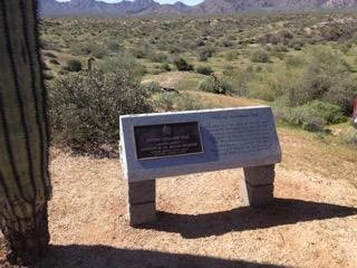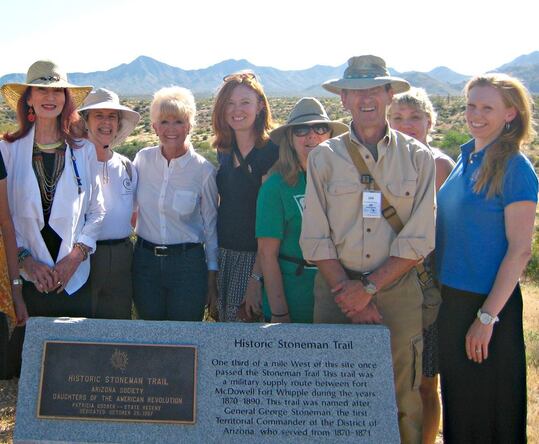Fort McDowell:
Stoneman Military Trail Marker
Marker:
Stoneman Military Trail Marker
Location:
Granite Trail
McDowell Mountain Regional Park
16300 McDowell Mountain Park Drive
Fort McDowell, Maricopa County, Arizona
33.692129, -111.740390
Directions:
As soon as you pass the nature center, turn left (toward the campgrounds) on Thoms Thumb Drive, then left on N. Pallisades Way/Pemberton Drive. The trailhead entrance to Spur Trail is at the #9 restroom. Take Spur Trail to Granite Trail south (left). The marker and bench are a moderate distance down on the right. The trail is easy to walk. Once there you will overlook Pemberton Wash with the Stoneman Wash Trail within it. Here is a remnant of the historic Stoneman Military Trail.
Note:
There is an entrance fee into the park.
Historical Significance:
From 1870 to 1890, the Stoneman Road was an important conduit for the shipping of supplies from Fort Whipple in Prescott to Fort McDowell on what is today the Yavapai Reservation near Fountain Hills. The route, of which only minimal traces remain, was named after 48‑year old Colonel George Stoneman.
Established in 1865, Fort McDowell was continuously short on supplies. The shortages were especially acute as the connection between the forts required a long route that swung south through Phoenix and north to Prescott. With the establishment of the Stoneman Road, a day’s ride was eliminated from the trip. On April 10, 1890, Fort McDowell was vacated by the U.S. military and became the Fort McDowell Indian Reservation, serving the Mohave, Pima, and Apache tribes. Only minimal traces are left of the Stoneman Road, due to the lack of traffic after 1890 combined with the passing of time and the Arizona weather.
Link:
Maricopa County Parks and Recreation – McDowell Mountain Regional Park
Dedicated:
October 25, 1997
Sponsor:
Arizona State Society, DAR
Rededication:
March 19, 2016
Sponsor:
Grand Canyon Chapter, NSDAR
Details:
Grand Canyon Chapter, NSDAR, commemorated the finished restoration of the Stoneman Trail Military Route Marker at McDowell Mountain Park. Grand Canyon Chapter, NSDAR, was awarded a grant by the National Society for the marker restoration with further funding for the project made possible through the sponsorship of the chapter.
The original bronze plaque reads, “Historic Stoneman Trail / Arizona Society / Daughters of the American Revolution / Patricia Godber — State Regent / Dedicated October 25, 1997.” The 2016 addition reads, “Historic Stoneman Trail / One third of a mile West of this site once passed the Stoneman Trail. This trail was a military supply route between Fort McDowell [and] Fort Whipple during the years 1870-1890. This trail was named after General George Stoneman, the first Territorial Commander of the District of Arizona, who served from 1870-1871.”
Work on the project entailed replacing the original wood marker with marble and retaining the original bronze plaque. Kandy Wagenbach, chairman of Grand Canyon Chapter, NSDAR, Special Grants Committee, said, “I want to thank the National Society DAR officers and chairmen who made the Special Projects grant available to our chapter, the Arizona State DAR officers for their support, and chapter members for their role in the project’s rededication.”
Courtesy of Sonoran News.com

Undated.

November 2018.
Request Membership Information
The content contained herein does not necessarily represent the position of NSDAR. Hyperlinks to other sites are not the responsibility of the NSDAR, the state organization or individual DAR chapters.
Unless otherwise noted, images are courtesy of Arizona State Society, DAR, Daughters.

March 19, 2016.
